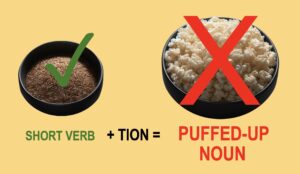Why not use hype in a white paper?
While every company is unique, a lot of white papers share the same problems.
How can I put this delicately?
 Many white papers suffer from an over-abundance of wishful thinking, unattributed factoids, vacuous logic… and good old-fashioned hype.And there’s no place where hype is less welcome than in your next white paper.
Many white papers suffer from an over-abundance of wishful thinking, unattributed factoids, vacuous logic… and good old-fashioned hype.And there’s no place where hype is less welcome than in your next white paper.
Hype doesn’t work for skeptical IT managers, cynical journalists, or cautious analysts.
Hype is especially inappropriate in a white paper, where readers are looking for precise technical background and real-world business benefits.
If you give them hype, you can likely kiss your good name goodbye.
That’s why I believe one of the top priorities for any white paper writer must be to seek out and destroy hype.
But what is hype?
Hype is short for “hyperbole.” From the ancient Greek, this literally means “excess” and “to throw over.” Think “over the top” and you’re on the right track.
Hype appears in many guises:
- Overblown claims
- Extravagant exaggerations
- Over-excited tone
- Excessive punctuation, à la Tom Wolfe!!!
As one of my colleagues says, “Nothing screams hype like an exclamation mark!”
Here are some examples that should have your own personal “hype detector” sounding a red alert:
▶ “Our best-selling network analyzer…”
from a company that only sells two different network analyzers.
▶ “A vast majority of IT managers prefer commercial software to Open Source…”
But where is the actual statistic, the survey methodology and the name of the study’s sponsor? Was this research sponsored by a company that perceives Open Source as a major threat?
▶ “Now shipping! Our most comprehensive update ever! Complete with 99 new and improved features!”
But does that number include long-advertised features that for the first time work properly because you finally got around to fixing the bugs?
If hype doesn’t work, why is it so common?
I believe that most hype springs from two sources: inexperience and arrogance.
Inexperience is perhaps excusable in a new writer doing their first-ever white paper. An unseasoned writer will most likely ask what an engineer or manager thinks and simply drop whatever they say into their document.
With no objective outsider to challenge any basic assumptions, a white paper can get caught in an endless loop of self-referential logic.
This is where a seasoned editor can question these assumptions and find evidence to support them.
Arrogance is tougher to root out.
Many technology companies are driven by what the founders feel is a genuine technical breakthrough. They may spend years proselytizing for their technology. They naturally attract a team of people that parrot this belief.
For instance, Steve Jobs is notorious for his “Reality Distortion Field” or his total disregard for practical limitations or market forces as he pursues his latest inspiration.
In the extreme, this can develop into a form of “groupthink” where everyone assumes their technology is superior, with no need for any proof. This becomes an article of faith and a badge of loyalty.
But simply stating that something is so does not make it so… particularly for someone outside your company.
Making this point to your management or client may be painful. But you owe it to them (and to yourself) to challenge any articles of faith and groupthink, and be sure they don’t find their way into your white paper.
What’s the alternative to hype?
I believe that an effective white paper presents useful information in a persuasive context based on:
- Concrete evidence
- Inarguable facts
- Impeccable figures
- Comments from recognized experts
- Stories from actual customers.
Your goal should be to think like a lawyer and write like a journalist.
In other words, gather all the evidence you need to make your case, then write so clearly that no one can possibly misunderstand what you’re saying.
If you do that, no hype will survive for long in your white paper.
Want to hear whenever there’s a fresh article on this site? Subscribe here to stay in the know on long-form content. From time to time, we’ll also send you word about some great new resource or training. And you can unsubscribe any time.



